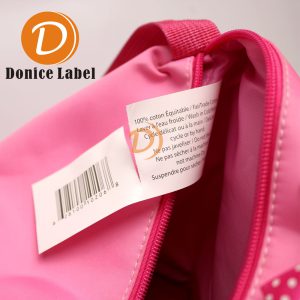Tag Reading
Tag reading refers to the process of interpreting and understanding the information provided on clothing or fabric tags. These tags typically contain important details related to the care, origin, and material composition of the item. Accurate tag reading ensures that consumers are able to properly care for their garments, follow safety instructions, and make informed purchasing decisions.
Key Elements of Tag Reading:
Fabric Composition
Clothing tags often list the fiber content or fabric composition of the garment, such as:
Cotton, Polyester, Wool, Silk, Nylon, etc. Understanding the fabric composition helps consumers know what kind of care the item requires, such as whether it needs to be hand-washed, dry-cleaned, or machine washed.
Washing Instructions
Tags provide vital information about how to clean the garment without damaging it. These instructions include symbols or written guidelines that specify:
Water temperature (e.g., cold, warm, or hot wash).
Washing method (machine wash, hand wash, dry clean).
Drying instructions (air dry, tumble dry on low, etc.).
Ironing temperature (low, medium, or high).
Country of Origin
Tags often list where the product was made. This information is important for consumers who may have preferences or concerns about the ethical sourcing or labor practices associated with a particular country.
Brand or Manufacturer Information
Many tags include the brand name or manufacturer’s details, including care instructions specific to that brand or product line. This is important for product identification and warranty information in case of defects.
Size Information
The size of the item is usually indicated in a standardized format, which may vary by country (e.g., small, medium, large, or numeric sizing). This helps consumers select the correct fit and size when purchasing clothing.
Safety Warnings
Certain garments, especially children’s clothing, may include safety warnings or precautions. These can include:
Flammability warnings (if applicable).
Choking hazards (for items with small components).
Allergen information (for items containing materials like wool or latex).
Care Symbols
Standardized care symbols are used worldwide to convey fabric care instructions in a simple, visual format. These include symbols for:
Washing (machine wash, hand wash, temperature limits).
Drying (air drying, tumble drying, etc.).
Ironing (temperature levels, steam).
Bleaching (safe or not safe to bleach).
Dry cleaning (specific solvent instructions).
Why Tag Reading Is Important:
Proper Care of Garments
Reading the care instructions on a tag ensures that the garment is washed, dried, and ironed according to its needs, preventing unnecessary damage. Incorrect care can cause fading, shrinkage, fabric wear, and loss of shape.
Fabric Longevity
By following the care guidelines provided on the tag, consumers can extend the lifespan of their clothing and textiles, ensuring they remain in good condition for longer.
Safety
Tags often include safety warnings about potential hazards, such as choking risks for children’s clothing or flammability warnings. Reading these tags helps consumers avoid accidents and ensures they are using the product as intended.
Sustainability
Tags may also provide details about the sustainability of the garment, such as whether it is made from recycled materials or if the manufacturer follows eco-friendly practices. This helps consumers make informed, eco-conscious purchasing decisions.
Compliance with Regulations
Many countries require certain information to be included on tags, such as the country of origin, fabric composition, and care instructions. Proper tag reading ensures consumers are following the legal requirements of their region, especially in the case of international purchases.
Consumer Empowerment
Tag reading empowers consumers by providing them with essential information to make better purchasing decisions. It helps them understand what to expect in terms of fit, care, and longevity, allowing them to take better care of their clothing.
How to Read a Tag:
Start with Fabric Composition
Look for the fabric content at the top or front of the tag. This tells you the materials used and can help you determine the appropriate washing method.
Check the Care Instructions
Review the care symbols to determine the recommended washing, drying, and ironing techniques. Each symbol has a specific meaning, so take note of the temperature limits and recommended methods.
Look for Size Information
Check the size information, which is usually listed alongside fabric composition or at the bottom of the tag. Be aware that sizing conventions may differ by region.
Find the Country of Origin
For ethical or legal reasons, the country of origin is often indicated. This is especially important for those concerned about labor practices or regulatory standards.
Pay Attention to Warnings
If the garment is intended for children or has special instructions, make sure to read any warnings or precautions listed on the tag.
Conclusion
Tag reading is an essential skill for ensuring that clothing and textiles are cared for properly, extending their lifespan and maintaining their quality. By carefully reviewing a garment’s fabric composition, care instructions, size, and other important details, consumers can make informed decisions about the best way to wash, dry, and iron their clothing. Tags serve not only as a guide for proper garment care but also as a valuable source of information about a product’s origin, brand, and safety.
Showing the single result
